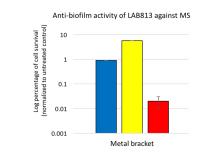BACKGROUND
Dental caries (i.e., cavities) occur in 60-90% of school children and nearly 100% of adults. Prevention of this oral disease continues to present serious challenges worldwide. These challenges persist in spite of the fact that caries is known to be a bacterially-mediated process for more than a century. Certain “human-friendly” bacteria which release antimicrobials have the potential to fight diseases caused by pathogenic biofilms. However, probiotics against dental caries have not worked well since many of these probiotic bacteria do not persist in the oral cavity.
TECHNOLOGY
Inventors at the University of Toronto have identified a Streptococcus salivarius strain, called LAB813, with probiotic potential. The strain was isolated from the dental plaque of a caries-free child and significantly inhibited the growth of nearly all the primary bacterial agent responsible for causing dental caries, i.e., mutans streptococci (MS) strains. The LAB813 strain is safe for human use and contains a megaplasmid encoding four putative inhibitory peptides responsible for its probiotic function. The isolated peptides by themselves may also serve as natural inhibitors.
COMPETITIVE ADVANTAGE
- Natural inhibitor of oral pathogens
- Efficacious – 99.9% killing efficiency against cariogenic biofilms
- Safe – isolated from a human; no known streptococcal virulence determinants or transferable antibiotic resistance genes
APPLICATIONS
- Probiotic against dental caries
- Coating on dental materials such as aligners (used for Invisalign orthodontic treatment)
- New natural therapeutic molecules for use in mouthwashes, toothpastes, gels and/or varnishes
INTELLECTUAL PROPERTY STATUS
- Provisional patent filed (2021)
PROJECT STATUS
Proof-of-concept studies have shown the ability of the LAB813 strain to inhibit 99.9% of MS cells in biofilms. Its safety has also been assessed and the likely source of the inhibition (four lantibiotic peptides) identified. Oral delivery of LAB813 on different dental materials (Figure 1) demonstrated its potential as a coating.
Figure 1. Potency of LAB813 in killing biofilm cells of mutan streptococci (MS) on the surfaces of saliva-coated dental materials (metal bracket, ceramic bracket, aligner). Mature biofilms were formed under conditions that mimic a sugar-rich diet. MS levels were measured in pre-formed biofilms of MS treated with LAB813 (blue) or biofilms of LAB813 co-incubated with MS (yellow) and LAB813 biofilm coating on material surface (red). LAB813 possesses strong anti-biofilm properties. Biofilm killing of 99% was obtained when LAB813 was tested against pre-formed biofilm. Pre-coating of the appliances with LAB813 showed inhibitory activities of 99.9% for all materials.





